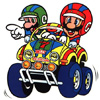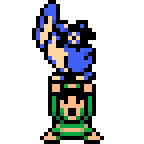Post by Deleted on Nov 3, 2009 11:15:56 GMT -5
Cross-posted over at LVLs.
One thing I love about the Smash Bros. games is how their effect on old/obscure/dried-up franchises is nigh magical; the series has rejuvenated so many of those franchises that it's almost silly, bringing both big and small titles back from the brink. The fact that Smash Bros. games are pretty much advertisements for what Nintendo has to offer helps, of course (I got into WarioWare and Pikmin because of Brawl), but the truth is out there, friends, and it dates back to the very first installment of the series.
Samus is a prime (heh) example here; by the time SSB on the N64 rolled around, Nintendo's first bounty hunter/mercenary/whatever they want her to be this week had only had three games, the last of which emerging five years prior to SSB's debut. Metroid games have always been great, but Samus' inclusion in SSB - which had been a long shot and a surprising choice at the time - really put her on the map, because three years following the first Smash Bros. game (and eight years since Super Metroid), two new Metroid games launch side-to-side: Metroid Prime and Metroid Fusion. From here, the Metroid franchise just fucking took off like a rocket; Prime would receive two sequels (and then a compilation of all three games) and two spin-offs, the original Metroid would be released in the GBA as part of the Classic NES Series and then remixed for the GBA title Metroid Zero Mission, and in the future we have Metroid: Other M to look forward to. Metroid and Samus went from being franchise underdogs to absolute power players in the Nintendo market, becoming one of their biggest, most dominating franchises, especially amongst the western audiences. Perhaps a show of this strength can be found in Super Smash Bros. Brawl, being one of the few series represented by more than one new stage and carrying a massive, largely remixed song set - not to mention the inclusion of Zero Suit Samus as an additional character (a design first introduced in Metroid Zero Mission and teased at in the original Metroid game with the Justin Bailey code), and two boss characters in The Subspace Emissary.
The Earthbound/MOTHER series has received a much lower degree of success, Ness being largely unknown to gamers by the time the first Smash Bros. came about, but the amount of popularity it's garnered hasn't hurt. Unfortunately, Nintendo doesn't seem intent to bring the love to the Western audience, what with a lack of Earthbound on the Virtual Console and a translated version of MOTHER 3. But Ness (and now Lucas) are known characters, whereas Western audiences would have absolutely no idea if Ness hadn't been acknowledge in Super Smash Bros.
And let's not forget Captain Falcon and the F-Zero franchise; due to the good Captain's inclusion in Smash Bros., the F-Zero series boomed, receiving several GBA spin-off titles (of dubious quality) and (a rarity for Nintendo franchises) an anime in its honor (also of dubious quality, but hey, it's sort of flattering I guess). While there haven't been many mainstream F-Zero games (only three overall), Captain Falcon's continued presence in Smash Bros. titles and his immense popularity amongst fans (mostly as a meme, but still) guarantees that F-Zero will continue to live on in some form or another.
Then comes Super Smash Bros. Melee, where three largely unheard-of franchises come to light: Ice Climber, Fire Emblem and Game & Watch. In the cases of the first and third, much like Earthbound, the most to happen was raise fan-based awareness; thanks to Melee, Nintendo fans who didn't know better could associate Game & Watch to the company, providing a greater interest in the series, and Ice Climber, like the original Metroid, received a port in the Classic NES Series on the GBA.
Fire Emblem, however, managed to walk away the winner of those three; previously a Japan-only series, Nintendo took a gambit by including Marth and Roy in the US, European and Australian releases. While there was an ulterior motive involved (promoting Fire Emblem 6 and it's US debut, thanks to Roy's inclusion in Melee), the gambit ultimately succeeded as now Fire Emblem has a place amongst English-speaking countries and has seen numerous sequels in the time since Melee's release. Marth's presence in both Melee and Brawl also increased awareness of him as a character; this, I'm sure, is what prompted Nintendo to re-make the original Fire Emblem for the Nintendo DS, with spiffy new graphics and everything.
And then, there's Brawl.
In this case, it's mostly the Assist Trophies that do the advertising here, but a couple playable characters also contribute:
It just goes to show how much weight and power a multi-franchise crossover fighting game can sling around.
One thing I love about the Smash Bros. games is how their effect on old/obscure/dried-up franchises is nigh magical; the series has rejuvenated so many of those franchises that it's almost silly, bringing both big and small titles back from the brink. The fact that Smash Bros. games are pretty much advertisements for what Nintendo has to offer helps, of course (I got into WarioWare and Pikmin because of Brawl), but the truth is out there, friends, and it dates back to the very first installment of the series.
Samus is a prime (heh) example here; by the time SSB on the N64 rolled around, Nintendo's first bounty hunter/mercenary/whatever they want her to be this week had only had three games, the last of which emerging five years prior to SSB's debut. Metroid games have always been great, but Samus' inclusion in SSB - which had been a long shot and a surprising choice at the time - really put her on the map, because three years following the first Smash Bros. game (and eight years since Super Metroid), two new Metroid games launch side-to-side: Metroid Prime and Metroid Fusion. From here, the Metroid franchise just fucking took off like a rocket; Prime would receive two sequels (and then a compilation of all three games) and two spin-offs, the original Metroid would be released in the GBA as part of the Classic NES Series and then remixed for the GBA title Metroid Zero Mission, and in the future we have Metroid: Other M to look forward to. Metroid and Samus went from being franchise underdogs to absolute power players in the Nintendo market, becoming one of their biggest, most dominating franchises, especially amongst the western audiences. Perhaps a show of this strength can be found in Super Smash Bros. Brawl, being one of the few series represented by more than one new stage and carrying a massive, largely remixed song set - not to mention the inclusion of Zero Suit Samus as an additional character (a design first introduced in Metroid Zero Mission and teased at in the original Metroid game with the Justin Bailey code), and two boss characters in The Subspace Emissary.
The Earthbound/MOTHER series has received a much lower degree of success, Ness being largely unknown to gamers by the time the first Smash Bros. came about, but the amount of popularity it's garnered hasn't hurt. Unfortunately, Nintendo doesn't seem intent to bring the love to the Western audience, what with a lack of Earthbound on the Virtual Console and a translated version of MOTHER 3. But Ness (and now Lucas) are known characters, whereas Western audiences would have absolutely no idea if Ness hadn't been acknowledge in Super Smash Bros.
And let's not forget Captain Falcon and the F-Zero franchise; due to the good Captain's inclusion in Smash Bros., the F-Zero series boomed, receiving several GBA spin-off titles (of dubious quality) and (a rarity for Nintendo franchises) an anime in its honor (also of dubious quality, but hey, it's sort of flattering I guess). While there haven't been many mainstream F-Zero games (only three overall), Captain Falcon's continued presence in Smash Bros. titles and his immense popularity amongst fans (mostly as a meme, but still) guarantees that F-Zero will continue to live on in some form or another.
Then comes Super Smash Bros. Melee, where three largely unheard-of franchises come to light: Ice Climber, Fire Emblem and Game & Watch. In the cases of the first and third, much like Earthbound, the most to happen was raise fan-based awareness; thanks to Melee, Nintendo fans who didn't know better could associate Game & Watch to the company, providing a greater interest in the series, and Ice Climber, like the original Metroid, received a port in the Classic NES Series on the GBA.
Fire Emblem, however, managed to walk away the winner of those three; previously a Japan-only series, Nintendo took a gambit by including Marth and Roy in the US, European and Australian releases. While there was an ulterior motive involved (promoting Fire Emblem 6 and it's US debut, thanks to Roy's inclusion in Melee), the gambit ultimately succeeded as now Fire Emblem has a place amongst English-speaking countries and has seen numerous sequels in the time since Melee's release. Marth's presence in both Melee and Brawl also increased awareness of him as a character; this, I'm sure, is what prompted Nintendo to re-make the original Fire Emblem for the Nintendo DS, with spiffy new graphics and everything.
And then, there's Brawl.
In this case, it's mostly the Assist Trophies that do the advertising here, but a couple playable characters also contribute:
- Pit has skyrocketed the general awareness of the Kid Icarus series, although we have yet to see a new installment to the franchise
- Little Mac's inclusion has spurned a new Punch-Out!! title after so many years of idling
- Saki, in tandem with the Virtual Console translation of the original Sin & Punishment some years after it's Japanese release, has drawn attention to the series and allowed a world-wide release of S&P2
- Lucas and Porky have further promoted MOTHER, particularly MOTHER3 (irritating western gamers with a Japanese-only release for the title)
- To a lesser extent, Jeff increased awareness of Earthbound
- Olimar's presence cements the Pikmin series as a power player
- People actually know who R.O.B. is now
- Starfy being an Assist Trophy has finally brought the titular character's series to the west
- And finally, Isaac's presence has spurned a new Golden Sun game.
It just goes to show how much weight and power a multi-franchise crossover fighting game can sling around.





 Either that, or nobody likes anything that isn't a playable fighter in Smash.
Either that, or nobody likes anything that isn't a playable fighter in Smash.







 ).
).